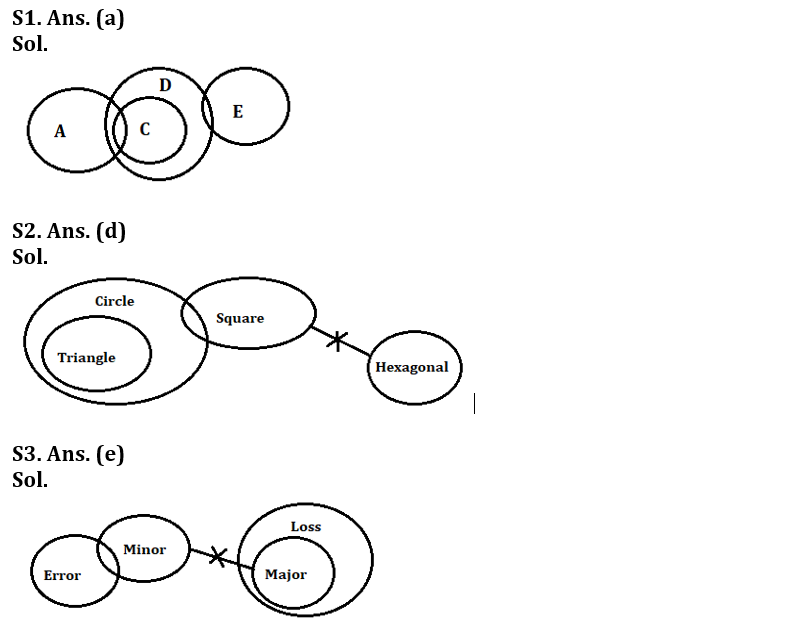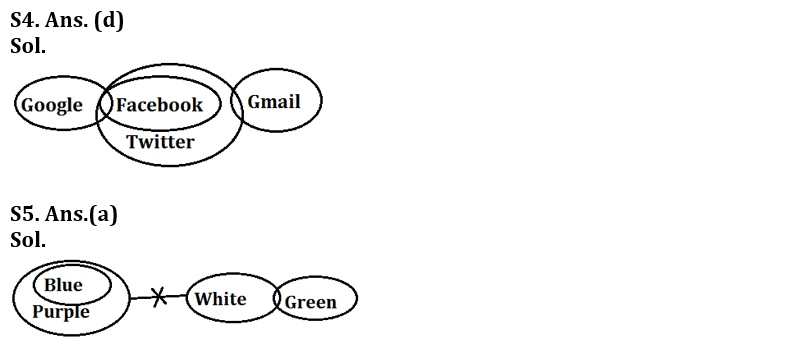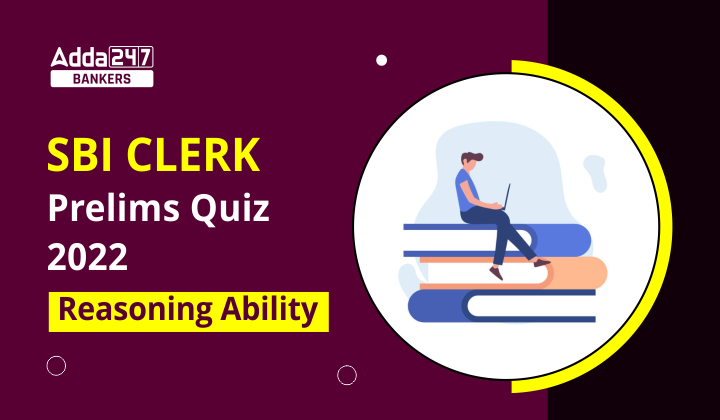Direction (1-3): In each of the questions below some statements are given followed by two conclusions. You have to take the given statements to be true even if they seem to be at variance with commonly known facts. Read all the conclusions and then decide which of the given conclusions logically follows from the given statements disregarding commonly known facts.
Q1. Statements: Some A are C.
All C are D.
Only a few D is E.
Conclusion: I: All E can be C
II: Some A are not E
(a) If only conclusion I follows.
(b) If only conclusion II follows.
(c) If either conclusion I or II follows.
(d) If neither conclusion I nor II follows.
(e) If both conclusions I and II follow.
Q2. Statements: Only Circle is triangle.
Some circle is Square.
No square is Hexagonal
Conclusion: I: All circle can be hexagonal.
II: Some square is triangle
(a) If only conclusion I follows.
(b) If only conclusion II follows.
(c) If either conclusion I or II follows.
(d) If neither conclusion I nor II follows.
(e) If both conclusions I and II follow.
Q3. Statements: Some Error are Minor.
No Minor is Major.
All Major are Loss
Conclusion: I: Some Loss are not Minor.
II: Some Error are not Major.
(a) If only conclusion I follows.
(b) If only conclusion II follows.
(c) If either conclusion I or II follows.
(d) If neither conclusion I nor II follows.
(e) If both conclusions I and II follow.
Directions (4-5): In each question below some statements are given followed by some conclusions. You have to assume everything in the statements to be true even if they seem to be at variance with commonly known facts and then find out which of the five given conclusions does not logically follow from the statements, disregarding commonly known facts.
Q4. Statements: Some Google are Facebook
All Facebook are Twitter.
Some Twitter are Gmail.
Conclusions:
(a) Some Twitter are Google.
(b) All Twitter are Facebook is a possibility.
(c) Some Gmail is Google is a possibility.
(d) All Gmail are Google.
(e) Some Twitter are Facebook
Q5. Statements: All Blue are Purple.
No Purple is White.
Some Green are White.
Conclusions:
(a) All Green being Purple is a possibility.
(b) Some Purple are Blue.
(c) Some Blue are not White.
(d) Some Green are not Purple
(e) All Green are White is a possibility.
Directions (6-8): In each of the question, relationships between some elements are shown in the statements(s). These statements are followed by conclusions numbered I and II. Read the statements and give the answer.
Q6. Statements: C < M >N = T, C ≤ V, M > R
Conclusions: I. N > R II. V > T
(a) If only conclusion I follows.
(b) If only conclusion II follows.
(c) If either conclusion I or II follows.
(d) If neither conclusion I nor II follows.
(e) If both conclusions I and II follow.
Q7. Statements: C ≥ D< T = F ≥ G, C < W
Conclusions: I. T =G II. G< T
(a) If only conclusion I follows.
(b) If only conclusion II follows.
(c) If either conclusion I or II follows.
(d) If neither conclusion I nor II follows.
(e) If both conclusions I and II follow.
Q8. Statements: R < T < S < P > Q, R> X
Conclusions: I. S < Q II. X < S
(a) If only conclusion I follows.
(b) If only conclusion II follows.
(c) If either conclusion I or II follows.
(d) If neither conclusion I nor II follows.
(e) If both conclusions I and II follow.
Directions (9-11): In these questions, relationship between different elements is show in the statements. The statements are followed by conclusions. Study the conclusions based on the given statements and select the appropriate answer:
Q9. Statements: H>S>T<V> D, M<T>U
Conclusion I: V>M II: H>U
(a) If only conclusion I follows.
(b) If only conclusion II follows.
(c) If either conclusion I or II follows
(d) If neither conclusion I nor II follows.
(e) If both conclusions I and II follow.
Q10. Statements: R>E≥V=G≥S, T<V≤W
Conclusion I: S=W II: W>S
(a) If only conclusion I follows.
(b) If only conclusion II follows.
(c) If either conclusion I or II follows
(d) If neither conclusion I nor II follows.
(e) If both conclusions I and II follow.
Q11. Statements: D>G<Y>Q, P>Y, G>T
Conclusion I: Q>T II: T<P
(a) If only conclusion I follows.
(b) If only conclusion II follows.
(c) If either conclusion I or II follows
(d) If neither conclusion I nor II follows.
(e) If both conclusions I and II follow.
Q12. In which of the following expression will the expression ‘G < A’ holds true?
(a) G≤E=H>A≤D
(b) H>E=D<A≥B=G
(c) A<B=D≥E=G
(d) E<G≥D>B≥A=H
(e) G≤D<E≤A<B
Q13. if the given expression ‘A<B≥C>D=E’ is definitely true, then which of the following expressions will be true?
(a) A<D
(b) E≥B
(c) C≤E
(d) E<A
(e) None is true
Q14. If the expressions, ‘W>U≤X<T,’V≥X’ and ‘X≥Z’ are true then which of the following combinations will be definitely true?
(a) U ≥ Z
(b) W < Z
(c) V = Z
(d) U ≤ V
(e) None of these
Q15. Which of the following symbols should replace the sign (#) and (&) respectively in the given expression in order to make the expression E < F and C ≥ D definitely true?
B < E ≤ G = H < D # F ≤ A & C
(a) ≥, =
(b) ≥, ≤
(c) >, ≤
(d) =, ≤
(e) ≥, <
Solutions


S6. Ans. (d)
Sol. I. N > R (False) II. V > T (False)
S7. Ans. (c)
Sol. I. T =G (False) II. G < T (False)
S8. Ans. (b)
Sol. I. S < Q (False) II. X < S (True)
S9. Ans. (e)
Sol. I: V>M(True) II: H>U(True)
S10. Ans. (c)
Sol. I: S=W(False) II: W>S(False)
S11. Ans. (b)
Sol. I: Q>T(False) II: T<P(True)
S12. Ans. (e)
S13. Ans. (e)
S14. Ans. (d)
S15. Ans. (d)





 GA Capsule for SBI Clerk Mains 2025, Dow...
GA Capsule for SBI Clerk Mains 2025, Dow...
 The Hindu Review October 2022: Download ...
The Hindu Review October 2022: Download ...
 ECGC PO Scorecard 2025 Out, Check Marks
ECGC PO Scorecard 2025 Out, Check Marks




